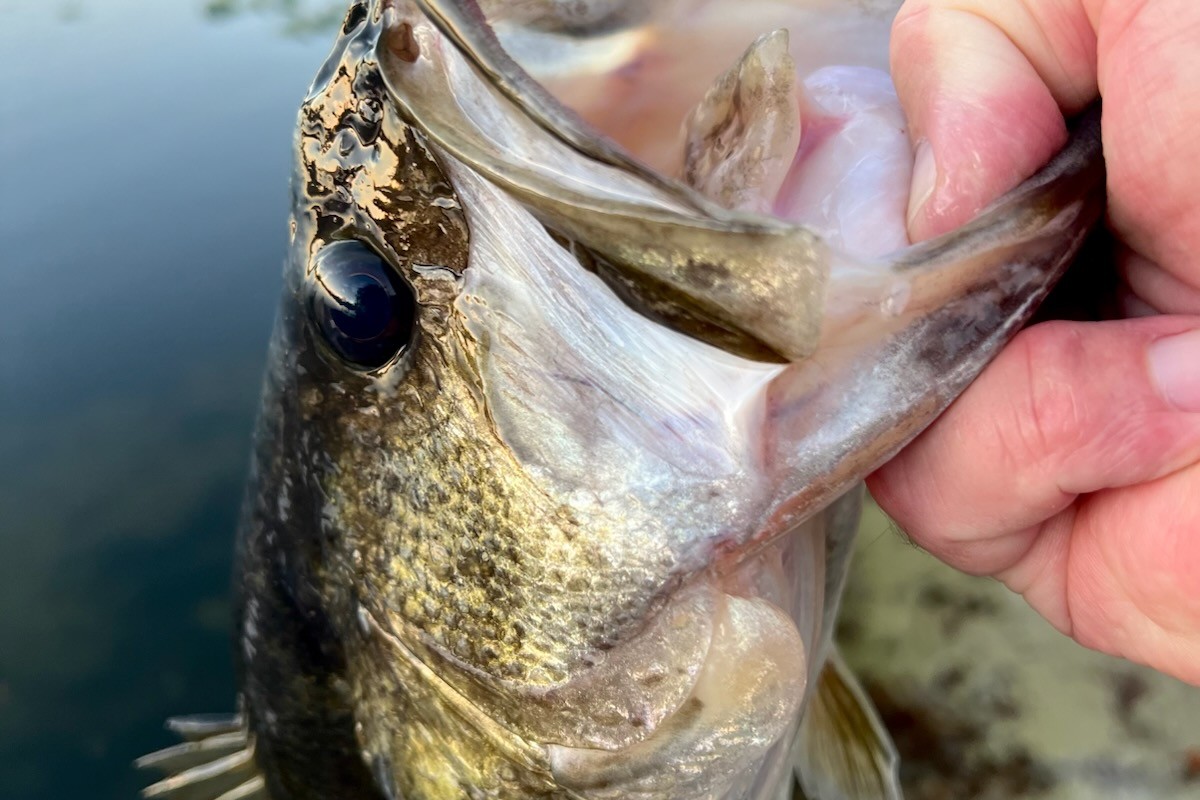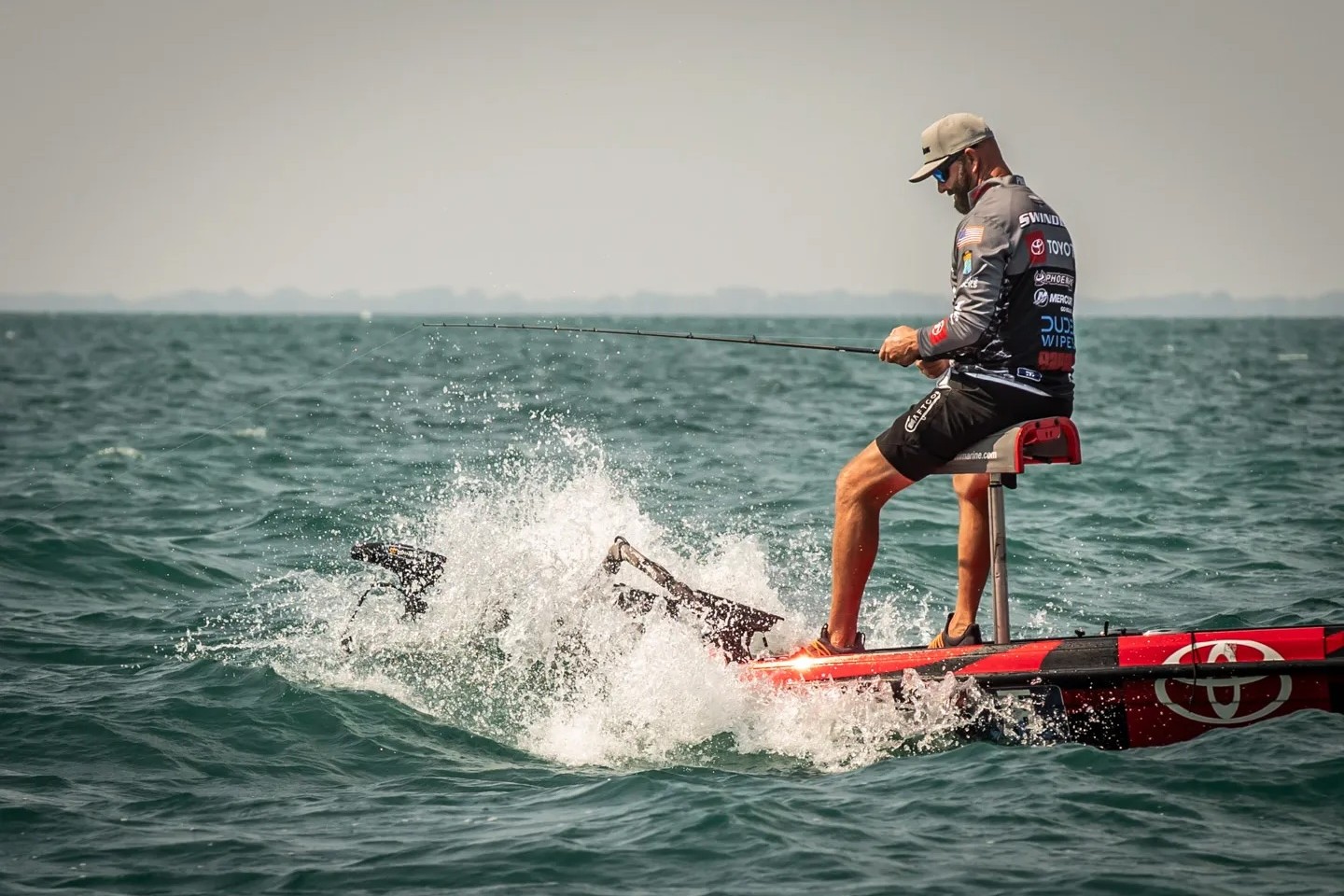STEP UP YOUR SWIMBAIT GAME WITH STRATEGIC MODIFICATIONS
By David A. Brown
They’re one of your most versatile big-fish baits with broad-ranging applicability and user-friendly operation. Ultra-limber and built for steady kicking action, a soft body swimbait appeals to everything from prespawn staging fish to those taking up ledge residence. Nevertheless, as effective as these baits can be, improvement is only a tweak away.
Here’s a hodgepodge of tips from pros who spend a lot of time behind a swimbait.
WEAR AND TEAR MINIMIZED
Fishing several of Alabama’s top bass factories, guide Brent Crow favors the Strike King Shadalicious for its cast-and-reel simplicity. On the good side, the bait usually gets a lot of bites. On the bad side, the bait usually gets a lot of bites.
The problem, he said, is all the downtime spent rerigging each time a bass ravages one of his baits. So, whether he’s catering to clients or fishing a tournament, Crow maximizes his time on the water with some prudent prep work.
Crow starts by slicing an inch-long slit in the bait’s back. This allows maximum motion for the 1/2-ounce Strike King Squadron jig head.
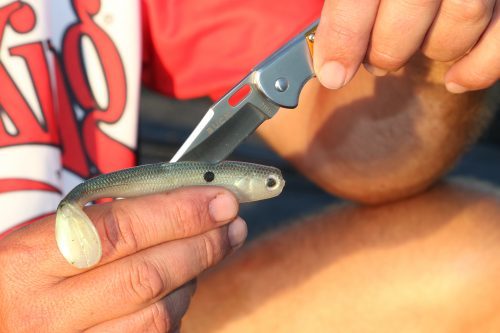
“This doesn’t really affect the action, but keeps the hook from tearing the bait when a fish shakes its head,” Crow said. “When you make that opening in the back of the bait it allows the hook to move back and forth.”
Contrasting this liberal movement, Crow wants the exact opposite for his swimbait head. Now, most anglers know to glue 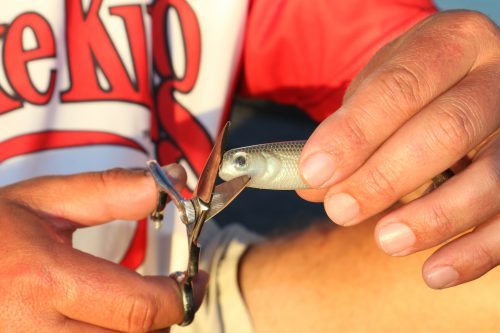 their plastics to their lead heads, but Crow refines this by snipping the tip of his Shadalicious to remove the rounded nose
their plastics to their lead heads, but Crow refines this by snipping the tip of his Shadalicious to remove the rounded nose
and create flat edged. The advantage: Greater surface area contacting the Squadron head.
Moderation is key here, as Crow keeps his gluing to a minimum.
“One or two drops is all you need,” he said. “If you use too much it can create a gap between your plastic and your swimbait head that looks unnatural. Also, the more glue you  use, the longer it takes to dry.”
use, the longer it takes to dry.”
Crow maximizes these benefits by preparing a couple dozen swimbaits with back slits and properly glued heads the night before a trip. Even with careful preparation, he’ll still have to replace a few swimbaits throughout the day, but starting with plenty of ammo
means fewer interruptions and more fishing time.
HIDE THE HEAD
FLW Tour Pro Michael Wooley showed me a trick he has used to add some wobble to his Shadalicious, and hide the swimbait head from wary fish. Rather than inserting the hook into the bait’s nose, running it out the back and snugging the lead head against the front end; he’ll use the hook point to cut a slit in the bait’s back at the point where the hook will eventually exit.
and hide the swimbait head from wary fish. Rather than inserting the hook into the bait’s nose, running it out the back and snugging the lead head against the front end; he’ll use the hook point to cut a slit in the bait’s back at the point where the hook will eventually exit.
Inserting the lead head here, he’ll push it all the way to the bait’s head where small slice allows the line tie to break through the plastic. Tucking the wide jig head inside the swimbait creates a
wobbling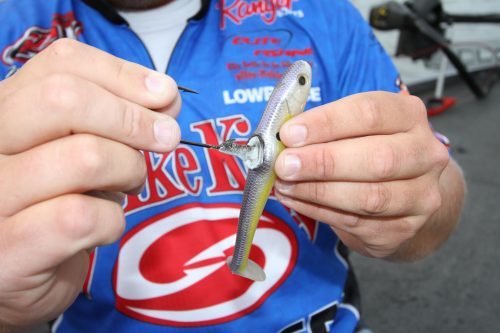 action that enhances the presentation.
action that enhances the presentation.
(Notably, Strike King introduced its Internal Swimbait Head at ICAST 2016. A narrow thumbnail shaped lead head with a 60-degree line tie, this model maintains the swimbait’s original shape for a more natural look.)
Thus arranged, the hook bend sits outside the bait as it would with a traditional arrangement, but the lead head remains shielded by  the bait’s plastic body. The benefit of this internal placement, he said is enhanced presentation.
the bait’s plastic body. The benefit of this internal placement, he said is enhanced presentation.
MORE BITE
When the fish are snapping, they’ll choke a swimbait; but when bites are less aggressive, extra grabbing power helps close the deal. We’re talking stingers here and, while premade deals like the Owner Stinger Harness offer a convenient option, you might want to consider a few other creative setups.
Slip-Ons: Run the point of your swimbait hook through the eye of a treble hook to add more bite for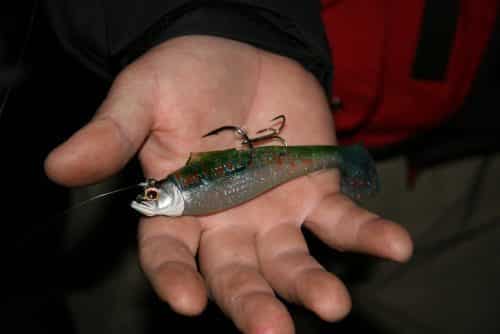 short strikers. You can pin the stinger in the bait’s back or let it swing free, but keep it from riding too far up the hook and possibly slipping off, add a trailer hook keeper to minimize the treble’s movement.
short strikers. You can pin the stinger in the bait’s back or let it swing free, but keep it from riding too far up the hook and possibly slipping off, add a trailer hook keeper to minimize the treble’s movement.
Same deal works with wide gap swimbait hooks. Just note that weighted models create their own hook keeper.
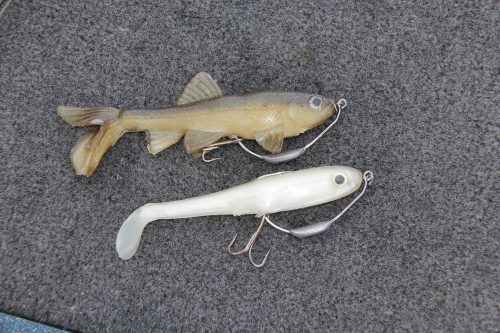 Side by Side: With a line through swimbait like the Osprey Talon, tie your line to the top eyelet of a 3-way swivel, add split rings to the remaining two eyelets and hang a treble hook from each. Instant double trouble.
Side by Side: With a line through swimbait like the Osprey Talon, tie your line to the top eyelet of a 3-way swivel, add split rings to the remaining two eyelets and hang a treble hook from each. Instant double trouble.
Make a Way: Solid swimbaits lacking a line-through can be modified for this arrangement by tying your line to a standard straight shank hook, running that hook through the bait’s nose and bringing it out the belly. Pull the line out through the bait, clip off the straight shank hook and add a treble.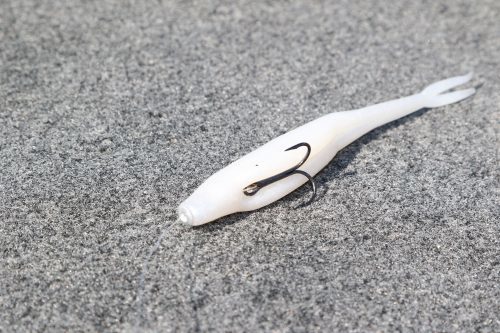
Another option, use a rivet sleeve to make a channel into the nose of a fluke style bait, run your line through this conduit and out the belly slot where you can tie it to a treble hook fitted with a split ring. Pinning one arm of the treble hook into the bait’s belly allows the other two to ride flush with the bait’s bottom edge.
MAX MOTION
In closing, let’s look at a cool tip from Bassmaster Elite Series pro and master tinkerer Terry Scroggins. Noting that even the softest and most flexible swimbait can benefit from a little extra motion, Scroggins uses a homemade hole punch he fashions from a wooden dowel and a piece of metal tubing.
Nothing fancy here — simply relieving a swimbait of a little mass creates additional wiggle points, plus it breaks up the bait’s normal profile. Small changes and probably not your definitive day maker; but when fish are seeing a lot of the same baits, those small departures, those slight variations can often turn lookers into biters.




